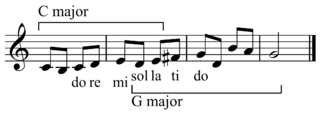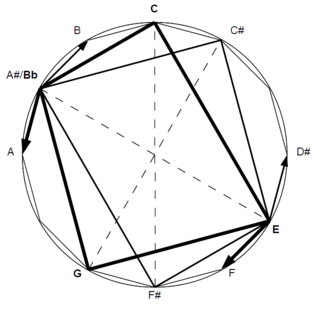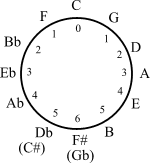
In music, harmony is the concept of combining different sounds together in order to create new, distinct musical ideas. Theories of harmony seek to describe or explain the effects created by distinct pitches or tones coinciding with one another; harmonic objects such as chords, textures and tonalities are identified, defined, and categorized in the development of these theories. Harmony is broadly understood to involve both a "vertical" dimension (frequency-space) and a "horizontal" dimension (time-space), and often overlaps with related musical concepts such as melody, timbre, and form.
In a musical composition, a chord progression or harmonic progression is a succession of chords. Chord progressions are the foundation of harmony in Western musical tradition from the common practice era of Classical music to the 21st century. Chord progressions are the foundation of popular music styles, traditional music, as well as genres such as blues and jazz. In these genres, chord progressions are the defining feature on which melody and rhythm are built.

In music, modulation is the change from one tonality to another. This may or may not be accompanied by a change in key signature. Modulations articulate or create the structure or form of many pieces, as well as add interest. Treatment of a chord as the tonic for less than a phrase is considered tonicization.
Modulation is the essential part of the art. Without it there is little music, for a piece derives its true beauty not from the large number of fixed modes which it embraces but rather from the subtle fabric of its modulation.

In music theory, the circle of fifths is a way of organizing pitches as a sequence of perfect fifths. Starting on a C, and using the standard system of tuning for Western music, the sequence is: C, G, D, A, E, B, F♯, C♯, G♯, D♯, A♯, E♯ (F), C. This order places the most closely related key signatures adjacent to one another. It is usually illustrated in the form of a circle.
A secondary chord is an analytical label for a specific harmonic device that is prevalent in the tonal idiom of Western music beginning in the common practice period: the use of diatonic functions for tonicization.
An augmented triad is a chord, made up of two major thirds. The term augmented triad arises from an augmented triad being considered a major chord whose top note (fifth) is raised. When using popular-music symbols, it is indicated by the symbol "+" or "aug". For example, the augmented triad built on A♭, written as A♭+, has pitches A♭-C-E:
In music, function is a term used to denote the relationship of a chord or a scale degree to a tonal centre. Two main theories of tonal functions exist today:
Chromaticism is a compositional technique interspersing the primary diatonic pitches and chords with other pitches of the chromatic scale. In simple terms, within each octave, diatonic music uses only seven different notes, rather than the twelve available on a standard piano keyboard. Music is chromatic when it uses more than just these seven notes.

In music theory, chord substitution is the technique of using a chord in place of another in a progression of chords, or a chord progression. Much of the European classical repertoire and the vast majority of blues, jazz and rock music songs are based on chord progressions. "A chord substitution occurs when a chord is replaced by another that is made to function like the original. Usually substituted chords possess two pitches in common with the triad that they are replacing."

The tritone substitution is a common chord substitution found in both jazz and classical music. Where jazz is concerned, it was the precursor to more complex substitution patterns like Coltrane changes. Tritone substitutions are sometimes used in improvisation—often to create tension during a solo. Though examples of the tritone substitution, known in the classical world as an augmented sixth chord, can be found extensively in classical music since the Renaissance period, they were not heard until much later in jazz by musicians such as Dizzy Gillespie and Charlie Parker in the 1940s, as well as Duke Ellington, Art Tatum, Coleman Hawkins, Roy Eldridge and Benny Goodman.
"Giant Steps" is a jazz composition by American saxophonist John Coltrane. It was first recorded in 1959 and released on the 1960 album Giant Steps. The composition features a cyclic chord pattern that has come to be known as Coltrane changes. The composition has become a jazz standard, covered by many artists. Due to its speed and rapid transition through the three keys of B major, G major and E♭ major, Vox described the piece as "the most feared song in jazz" and "one of the most challenging chord progressions to improvise over" in the jazz repertoire.

The Andalusian cadence is a term adopted from flamenco music for a chord progression comprising four chords descending stepwise – a iv–III–II–I progression with respect to the Phrygian mode or i–VII–VI–V progression with respect to the Aeolian mode (minor). It is otherwise known as the minor descending tetrachord. Traceable back to the Renaissance, its effective sonorities made it one of the most popular progressions in classical music.
In music, the axis system is a system of analysis originating in the work of Ernő Lendvai, which he developed in his analysis of the music of Béla Bartók.

In jazz, a turnaround is a passage at the end of a section which leads to the next section. This next section is most often the repetition of the previous section or the entire piece or song.
The ii–V–I progression is a common cadential chord progression used in a wide variety of music genres, including jazz harmony. It is a succession of chords whose roots descend in fifths from the second degree (supertonic) to the fifth degree (dominant), and finally to the tonic. In a major key, the supertonic triad (ii) is minor, and in a minor key it is diminished. The dominant is, in its normal form, a major triad and commonly a dominant seventh chord. With the addition of chord alterations, substitutions, and extensions, limitless variations exist on this simple formula.

Diatonic and chromatic are terms in music theory that are used to characterize scales. The terms are also applied to musical instruments, intervals, chords, notes, musical styles, and kinds of harmony. They are very often used as a pair, especially when applied to contrasting features of the common practice music of the period 1600–1900.
In music, harmonization is the chordal accompaniment to a line or melody: "Using chords and melodies together, making harmony by stacking scale tones as triads".

The Lydian Chromatic Concept of Tonal Organization is a 1953 jazz music theory book written by George Russell. The book is the founding text of the Lydian Chromatic Concept (LCC), or Lydian Chromatic Theory (LCT). Russell's work postulates that all music is based on the tonal gravity of the Lydian mode.
"26-2" is a musical composition written by American jazz musician John Coltrane. The song was recorded by Coltrane in 1960, but it released ten years later by Atlantic Records on an album entitled The Coltrane Legacy with a rhythm section composed of McCoy Tyner on piano, Steve Davis on bass, and Elvin Jones on drums. The composition itself is a contrafact of Charlie Parker's tune "Confirmation", with harmonic alterations to the original chord changes used by Coltrane in a number of his compositions. This harmonic modification is commonly known as Coltrane Changes, which have been most notably used in Coltrane's "Giant Steps". "26-2" is one of several contrafacts by Coltrane, others including "Countdown", a contrafact of Miles Davis's "Tune Up"; and "Satellite" from the album Coltrane's Sound, which is based upon the chord progression of "How High the Moon". Coltrane plays the first statement of the melody on tenor saxophone and switches to soprano saxophone for the last statement of the melody on the recorded version.
"Countdown" is a hardbop jazz standard composed by American jazz saxophonist John Coltrane that was first featured on his fifth studio album, Giant Steps, in 1960. The song is a contrafact of Miles Davis's "Tune Up", which is reharmonized to the Coltrane changes. The original recording has been described as having "resolute intensity. .. [that] does more to modernize jazz in 141 seconds than many artists do in their entire careers".













